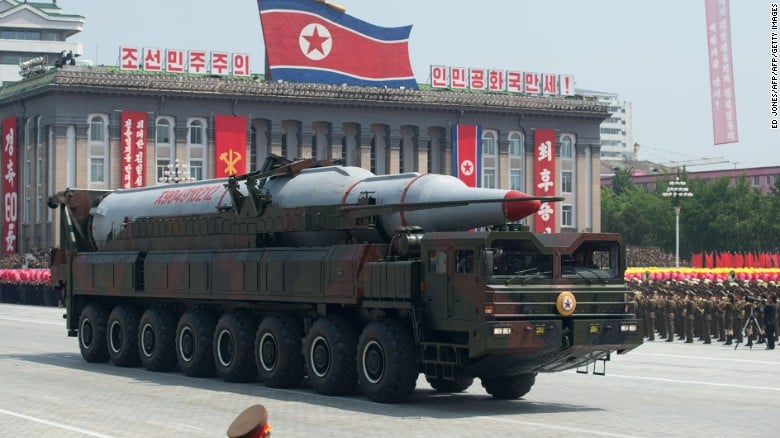
On June 22, North Korea launched two Musudan medium-range missiles, in defiance of the international warnings and sanctions from the UN. One of the two missiles successfully travelled 400 km and reached 1.000 km of altitude before vanishing in the Sea of Japan, close to the Honshu island, as reported by South Korea’s Joint Staff. Pyongyang’s unchallenged pursuit of its ballistic program reveals that international sanctions have not affected North Korea’s ability to develop nuclear strike capabilities.
This news was saluted by Pyongyang as an important step in the acquisition of advanced ballistic technology, vital to substantiate its threats toWashington and its regional allies. Japan and South Korea’s leaders have immediately denounced the missile test as an additional provocation, undermining international security and dialogue.
Japanese Minister of Defense Gen Nakatani declared the state of alert on Tuesday, ordering the SDF to intercept any incoming ballistic missiles entering the Japanese territory and waters. The Japanese Ministry of Defense also confirmed that DPRK’s midrange missiles could reach a potential range of 2.500 to 4.000 km, striking Japan but also a large part of the Asia-Pacific, including relevant American bases in the region.
Pyongyang’s Intermediate Range Ballistic Missiles (IRBM), based on Cold-war submarine missile technology, with a range of approximately 3.000 km, are still technically able to reach Japan, South Korea and even hit U.S. military bases in Guam. Kim Jong-un himself, has saluted the success of the test as a memorable achievement, stressing that the success of the recent test highlights North Korea’s capability to attack in an overall and practical way the Americans in the Pacific theatre as reported by the KCNA state news agency.

The implications of the new missile test
Albeit Washington has strongly opposed North Korea from developing intercontinental ballistic, the new missile test represents an evident shift in the regional balance of power. In the recent months, President Park has inaugurated a more assertive policy in response to North Korea’s brinkmanship, shutting down the Kaesong industrial complex and abandoning its traditional strategic patient approach, considered ultimately ineffective in pursuing the path of the denuclearization of the Korean peninsula.
Given the rising level of the threat represented by Pyongyang’s nuclear ambitions, South Korea has strongly increased its military budget in the last year with a further expansion ($32.5 billion), up 4% this year, in response to the imminent military threat represented by Pyongyang’s restlees nuclear ambitions.
In addition, developing longer-range surface-to-surface missiles and expanding the aircraft capabilities has become the most immediate strategic priorities for Seoul. As stressed by South Korea Minister of Defense, Han Minkoo in the recent Shangri-La Dialogue hosted in Singapore, on June 4th, South Korea will not tolerate any further provocations and threats that directly challenge the security and the peace of the Korean Peninsula.
Yet, Pyongyang’s unpredictable provocations, coupled with substantial progress in increasing its pre-emptive nuclear attack capability, could seriously undermine Washington’s role as a security provider in the region. North Korean provocations not only represent an evident threat to the regional security architecture but are also a frequent challenge to the credibility of the U.S. security commitment in the region.
Obama Administration’s engagement in strengthening the participation of its relevant allies such as Japan and South Korea in strategic initiatives, but also in expanding deterrence capabilities in the Korean Peninsula remains the most pressing issue in protecting the American core interest in the region. Yet, Washington’s desire to accelerate the deployments of advanced missile defence system such as the Terminal High Altitude Area Defense (THAAD) represents an additional source of concern for the fragile balance of the region, given the strong objections of China and Russia that consider the deployment of the American defence system a serious security threat.
In different occasions, Beijing has strongly opposed the deployment of THAAD in the peninsula claiming that its radar system could be used to monitor China’s military operations rather than being oriented to intercept any incoming missiles from the DPRK. While THAAD itself does not pose a direct threat to China, the Chinese leadership is increasingly concerned that the rising tensions could soon or later lead to a military intervention in Beijing’s backyard.
The Chinese leadership has spared no efforts in pursuing stability and denuclearization of the Korean peninsula, increasing the level of the pressure on Pyongyang that remains adamant in asserting its vocation as a Nuclear Power State. In the early June, a North Korea delegation, led by the former Foreign Minister and an influent member of the Politburo Ri Su-yong arrived in Beijing for a bilateral meeting, after the relations have gradually eroded as a consequence of the North Korea restless military provocations and missile tests that are risking to inflame the region.
Beijing has grown wary of the increase of the American strategic presence in the region under the auspice of the Rebalance to Asia strategy, inaugurated by Obama Administration in 2011. Besides, the dangers represented by the unpredictable behavior of the DPRK, the Chinese leadership considers the deployment of the THAAD and strengthening of the trilateral strategic cooperation with Japan and South Korea, a formidable plan orchestrated by Washington to contain China and undermine its core interest in the region.
While the North Korea remains a pressing concern for either China or the Unite States, Obama Administration has managed to consolidate its role in the region, but also fostering a new level of strategic engagement between Japan and South Korea, a critical pillar of Rebalance to Asia strategy.
The new trilateral agreement signed on the sidelines of the recent Shangri-La Dialogue is expected to boost the participation of Japan, South Korea in opposing Pyongyang’s threat to regional peace and security. On the other hand, the pursuit of a more assertive stance from Washington and its close allies could collide with China’s regional strategy, heightening the level of political and military tensions in the region and alimenting the perception of a plan to contain the Beijing’s claims of peaceful development.